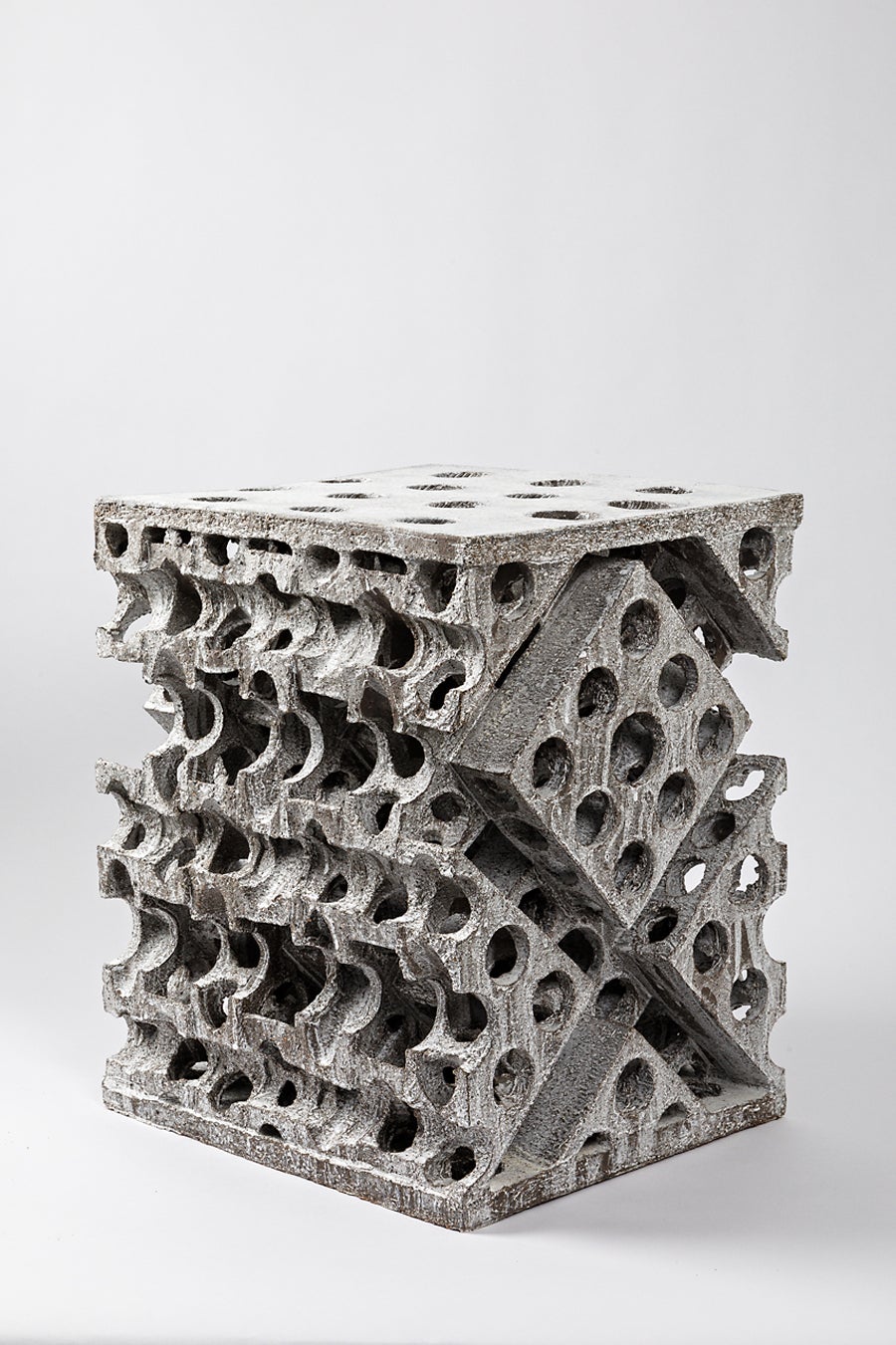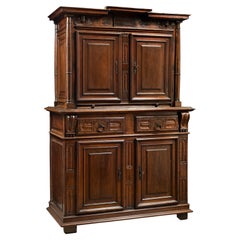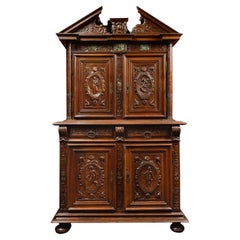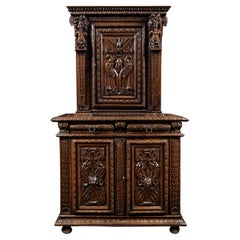Want more images or videos?
Request additional images or videos from the seller
1 of 5
16th Century Two Bodied Genoan "Stipo" Cabinet with a Bambocci Decor
$26,372.51List Price
About the Item
- Dimensions:Height: 72.84 in (185 cm)Width: 44.89 in (114 cm)Depth: 20.48 in (52 cm)
- Style:Renaissance (Of the Period)
- Materials and Techniques:
- Place of Origin:
- Period:16th Century
- Date of Manufacture:16th Century
- Condition:
- Seller Location:Saint-Ouen, FR
- Reference Number:1stDibs: LU3115327312212

About the Seller
5.0
Vetted Professional Seller
Every seller passes strict standards for authenticity and reliability
Established in 2016
1stDibs seller since 2017
197 sales on 1stDibs
Typical response time: 3 hours
Authenticity Guarantee
In the unlikely event there’s an issue with an item’s authenticity, contact us within 1 year for a full refund. DetailsMoney-Back Guarantee
If your item is not as described, is damaged in transit, or does not arrive, contact us within 7 days for a full refund. Details24-Hour Cancellation
You have a 24-hour grace period in which to reconsider your purchase, with no questions asked.Vetted Professional Sellers
Our world-class sellers must adhere to strict standards for service and quality, maintaining the integrity of our listings.Price-Match Guarantee
If you find that a seller listed the same item for a lower price elsewhere, we’ll match it.Trusted Global Delivery
Our best-in-class carrier network provides specialized shipping options worldwide, including custom delivery.You May Also Like
Magnificent 16th Century Italian Walnut Stipo
Located in Rio De Janeiro, BR
This magnificent Italian Renaissance stipo cabinet offers both an impressive aesthetic and functional versatility, reflecting its historical grandeur. Crafted in rich walnut, this st...
Category
Antique 16th Century Italian Renaissance Cabinets
Materials
Walnut
Genoese Cabinet Called Stipo From The Renaissance Period In Walnut - 16th Centur
Located in Brussels, Brussels
Exceptional Genoese cabinet called stipo "a bambocci" from the Italian Renaissance in walnut from the end of the 16th century with its original base
Museum quality piece
Provenance:...
Category
Antique 16th Century Italian Renaissance Cabinets
Materials
Walnut
$92,903
H 69.3 in W 40.95 in D 35.83 in
18th Century Baroque Cabinet with Secretaire, Germany, 1760
Located in Belmont, MA
18th century Baroque cabinet with secretaire, Germany, 1760, walnut veneer. Beautiful piece in excellent condition, professionally rest...
Category
Antique 1760s German Baroque Cabinets
Materials
Walnut
$17,600 Sale Price
20% Off
H 85.83 in W 40.16 in D 21.66 in
20th Century Dutch Writing Cabinet, 1960s
Located in Den Haag, NL
Dutch writing cabinet hand built by a master craftsman, circa 1960s featuring ornate inlay work and numerous drawers and compartments. Very impressive piece and great quality.
Category
Mid-20th Century Dutch Louis XVI Cabinets
Materials
Wood
16th Century Italian Renaissance Cabinet in walnut with rich carvings
Located in Meulebeke, BE
Italy / 16th Century / Cabinet / walnut / Renaissance / Antique
Rare 16th Century Italian Renaissance cabinet in walnut with hand carved decorations of 3 heads and floral patterns f...
Category
Antique 16th Century Italian Renaissance Cabinets
Materials
Walnut
$14,385
H 48.82 in W 61.42 in D 22.45 in
Important 16th Century Renaissance Florentine Drop Front Desk Cabinet
Located in Dallas, TX
An Italian Florentine Renaissance Carved Burl Walnut Fall-Front Writing Cabinet, Circa 1560, 16th century
From the Davanzatti Palace Museum in Florence
Height: 59 inches x 36 inches ...
Category
Antique 16th Century Italian Renaissance Cabinets
Materials
Iron
Early 20th Century Italian Louis XV Style Cabinet with Writing Desk
Located in Casale Monferrato, IT
Elegant Italian Louis XV Style cabinet with desk 1910s. This cabinet is characterized by a refined veneer in fine rosewood. The veneer is laid using the grain of the wood as a decora...
Category
Vintage 1910s Italian Louis XV Cabinets
Materials
Walnut
$7,672 Sale Price
20% Off
H 41.34 in W 41.34 in D 20.87 in
Early 18th Century French Petite Secretaire or Bureau with Projecting Cabinet
Located in Los Angeles, CA
This early 18th-century French dark wood secretary or fall-front bureau cabinet with charming proportions. Featuring a carved projecting cornice and arched front, original glass mirr...
Category
Antique 18th Century and Earlier French Secretaires
Materials
Wood
$4,875
H 65 in W 27.5 in D 16 in
RENAISSANCE TWO BODY CABINET 19th Century
Located in Madrid, ES
RENAISSANCE TWO BODY CABINET 19th Century
In oak wood
Upper part with two profusely carved doors.
Lower part with two drawers and two doors.
Decorated with plant motifs, zoomorphic ...
Category
Antique 19th Century Portuguese Baroque Cabinets
Materials
Wood
Light Gray 18th Century Period Swedish Two Part Secretary with Carved Pediment
Located in Tetbury, Gloucestershire
18th century period two part wood secretary with a decorative carved pediment. Two carved front doors open to storage, and beneath a fall front door ...
Category
Antique 18th Century Swedish Secretaires
Materials
Wood
$7,963
H 79.93 in W 48.82 in D 22.45 in
More From This Seller
View All16th Century Renaissance Two-Bodied Cabinet
Located in Saint-Ouen, FR
Former collection Altounian
At the beginning of the reign of Henri II (1547-1559) the furniture’s ornamentation evolves. The few medieval motifs that were still used are eventually relinquished. Furniture becomes more sober showcasing moulded panels and perfect architecture. Cabinet-makers use ornaments such as curved fluted or plain columns, feather quills, roses or winged putti heads. High-relief carving becomes more scarce and compositions lighter. To that end cabinet-makers draw inspiration from Fontainebleau motifs filtering them and adapting them to French taste.
During this period cabinet-makers turn into a kind of architects. Indeed the architectural balance of furniture is the centre of their concerns. The study of Antic formulas is then a necessity. From this care given to proportions appear refined cabinets with pure lines.
This style is characteristic of the reign of Henri II and disappears soon after under the regency of Catherine de Medici (1560-1574) when an abundance of high and low-relief ornaments comes back on furnitures.
This two-bodies cabinet...
Category
Antique 16th Century French Renaissance Cabinets
Materials
Walnut
16th Century French Walnut Cabinet with Marble Inlays
Located in Saint-Ouen, FR
On the left post of the lower body, is written the date 1596 in a cartouche
This cabinet has two bodies. The upper part, set back, is moulded and carved. At the bottom, the cabine...
Category
Antique 16th Century French Renaissance Cabinets
Materials
Walnut
16th Century French Carved Renaissance Cabinet
Located in Saint-Ouen, FR
Rare carved Renaissance cabinet
Period : 2nd half 16th century, ca. 1570
Origin : France, Burgundy or Languedoc
This cabinet embody the produ...
Category
Antique 16th Century French Renaissance Cabinets
Materials
Walnut
16th Century Cabinet with Knights Carving from Avignon Workshops 'France'
Located in Saint-Ouen, FR
Collection Jean Thuile
Around the mid-sixteenth century French furnishing evolves in its conception and ornamentation. The start of major archi...
Category
Antique 16th Century French Renaissance Cabinets
Materials
Walnut
Small Two-Body Buffet Decorated with Bird Quills
Located in Saint-Ouen, FR
Small two-body buffet decorated with bird feathers
ORIGIN : FRANCE
PERIOD : 16th CENTURY
Measures: height: 170 cm
length: 106 cm
depth: 51 cm
Walnut wood
This cha...
Category
Antique 16th Century Renaissance Cabinets
Materials
Walnut
Important Renaissance Cabinet from Lyon 'France' with a Decor of Perspectives
Located in Saint-Ouen, FR
As soon as 1540 France's second Renaissance is in the making, intimately linked to the rediscovery of the Antique world. The development of the printing and engraving industry allows the spread of artworks and models in many cities and countries. The Italian influence can be perceived in every artistic field. While the French king entrust the most talented Italian artists with major projects such as Il Rosso or Primaticcio in Fontainebleau, French artists also travel to Italy to form themselves to this new style. In Italy they get acquainted with the work of Leo Battista Alberti the first to theorize perspective (De Pictura, 1435-36) and architecture (De re oedificatoria, 1541). Those two publications would have a revolutionary impact on arts.
Furniture is marked by the work of the most famous Italian architects of the time as well as French architects. Indeed Philibert de l'Orme competes with Alberti and by the end of his life publishes several treaties including one devoted to a theory of architecture (1567). Unfortunately he would not live to complete the second volume. In this treaty he expresses his interest for mathematical norms applied to architecture, copied from the Antique. His journeys in Italy allowed him to accumulate the most sophisticated references. Jean Bullant, another architect of great talent also theorizes his practice. He establishes rules characterizing Greco-Roman art staying faithful to Vitruvius.
Following this new inspiration the structure of furniture evolves. From then on appear columns, capitals, cornices, friezes and architraves. The ornamentation uses this inspiration as well with egg-and-dart, palm leaf and rose adorning the most beautiful pieces.
In Lyon, crossroad where meet merchants from everywhere those new experiments are welcomed. Lyon florishing printing industry allows the spreading of models and treaties essential to the artist's work. Thus the first publication of Vitruvius' De Architectura in France would be printed in Lyon in 1532.
Artists from Lyon rediscover and familiarize themselves with the Antique knowledge very early. They adopt those new ideas and use them in their own creations. Lyon cabinet-makers re interpret Antique architecture and Italian Renaissance palaces to give their pieces a pure and harmonious architectural structure. Grooved pilasters are particularly favored. They are topped by capitals of diverse orders always respecting the sequencing with simpler ones for the lower levels and the richest ones on the higher levels. As for the ornamentation, one of the great distinctiveness of Lyon workshops remains the architectural perspective illusions, drawing inspiration from Tuscany.
True masterpiece of the Second French Renaissance this important cabinet illustrates Lyon workshops' taste for fine Italian architecture inspired by Antiquity. An architectural perspective of great quality is treated in symmetry on each panel.
This two-bodied cabinet without recess stands on four rectangular feet. The base comprises a molding, a palm leaf frieze and is bordered by a braid.
The lower body is divided by three grooved pilasters with Tuscan capitals framing two door-leaves. The two panels are encircled by a moudled frame with palm leaves. They are finely carved with a decor of fantasized architecture depicting an Italian Renaissance palace erected symmetrically on each side of a grooved pilaster. On the ground floor a door opens through a stilted arch while the stories are opened with mullioned windows, dormers and occuli. Two large pegged-boss cladded pillars support the entablature enriched by a palm leaf frieze upon which stands an arch whose coffered intrados is centred by a rose. Behind this arch a pyramid appears, standing in front of a second facade with a window topped by a broken curvilinear pediment under a cul-de-four with a shell.
The checker flooring gives depth to the low-reliefs creating vanishing points structuring the panels and guiding the eye of the observer.
A thin laurel braid highlights the belt of the cabinet where are located two drawers. Their facades are adorned by palm leaves in hoops.
The upper body is encircled with palm leaves. The same ternary division as in the lower body appears. However, the pilasters are topped by Ionic capitals with volutes and egg-and-dart. The door-leaves are framed with flowers. On the panels the artist has designed another architectural decor. On the foreground open two arches on top of grooved pilasters with rectangular capitals adorned with palm leaves. The arches are enriched with braids and the coffered intrados bears a decor of roses. The spandrels also bear a flower decor. In the background another arcature hosts a fluted grooved column topped with double basket acanthus capital, characteristic of Corinthian order. The triangular pediment is interrupted by a choux bourguignon.
A large cornice crowns the cabinet. It stands on pilasters and forms an entablature comprising a palm leaf frieze and an egg-and-dart, triglyph and palm leaf cornice.
The cabinet's sides have also been carefully considered. The lower body's panels are enriched with an arch rising above a broken pediment portico hosting a twisted column. Flowers garnish the spandrels. An architectural facade completes the decor. The upper body's panels present two arches supported by a facade opened with dormers and mullioned windows as well as cartouches (one bears the inscription 1580 dating the cabinet) suggesting the interior of an Italian Renaissance palace, confirmed by the chandeliers. The flooring leads our gaze to a second arch with a broken curvilinear pediment where stands a flower vase. This arch opens onto a perspective of another facade along a road.
Inside the cabinet, on the lower body door-leaves appear two designs. On the right door is depicted a Crucifixion. Saint Mary and Saint John flank the Christ on the cross. In the bottom part is inscribed « Dure uiator abis nihil haec spectacula curas / Pendenti cum sis unica cura Deo. / Tota suo moriente dolet natura Magistro. / Nil qui solus eras caussa dolenda doles. ». The signature [Christoff Swartz Monachiensis pinx[it] / Ioa[nnes] Sadeler sculp[it]] tells us it was made by Johan Sadeler I (1550-1600) after Christoph Schwartz (1548-1592). This engraving belongs to an ensemble depicting the Passion of Christ Johan Sadeler executed in 1589 after an altar piece painted by Christoph Schwartz for the private chapel of Renée of Loraine, wife of Duke William V of Bavaria. This altar piece made of nine copper panels has been destroyed during the 19th century. The Crucifixion panel once in the centre of the altar piece is the only one that survived and is today kept in Munich's Alte Pinakothek.
On the left door appears Saint Francis receiving the stigmata. The inscription says : « Signastidomine Servum Tuum. Franciscum. Signis Redemptionis Nostrae ».
This Renaissance cabinet with an architectural decor appearing as much in the structure faithful to Antique rules...
Category
Antique 16th Century European Renaissance Cabinets
Materials
Walnut
Recently Viewed
View AllMore Ways To Browse
16th Century Italian Walnut
16th Renaissance Walnut Italian
A Bambocci
Andre Charles Boulle
Sliding Door Cases
Hand Painted Black Lacquer Cabinet
Bleached Cabinet Oak
Industrial Metal Cabinets
Century Curio
Display Case Art
Modern Metal And Glass Display Cases
Inlay Panel
Indian Antique Furniture Cabinets Cabinets Indian
Dovetail Cabinet
Dutch Oak Cabinet
Antique Furniture Restoration
Dutch Kitchen Cabinet
Antique Chinese Cabinet Elm



